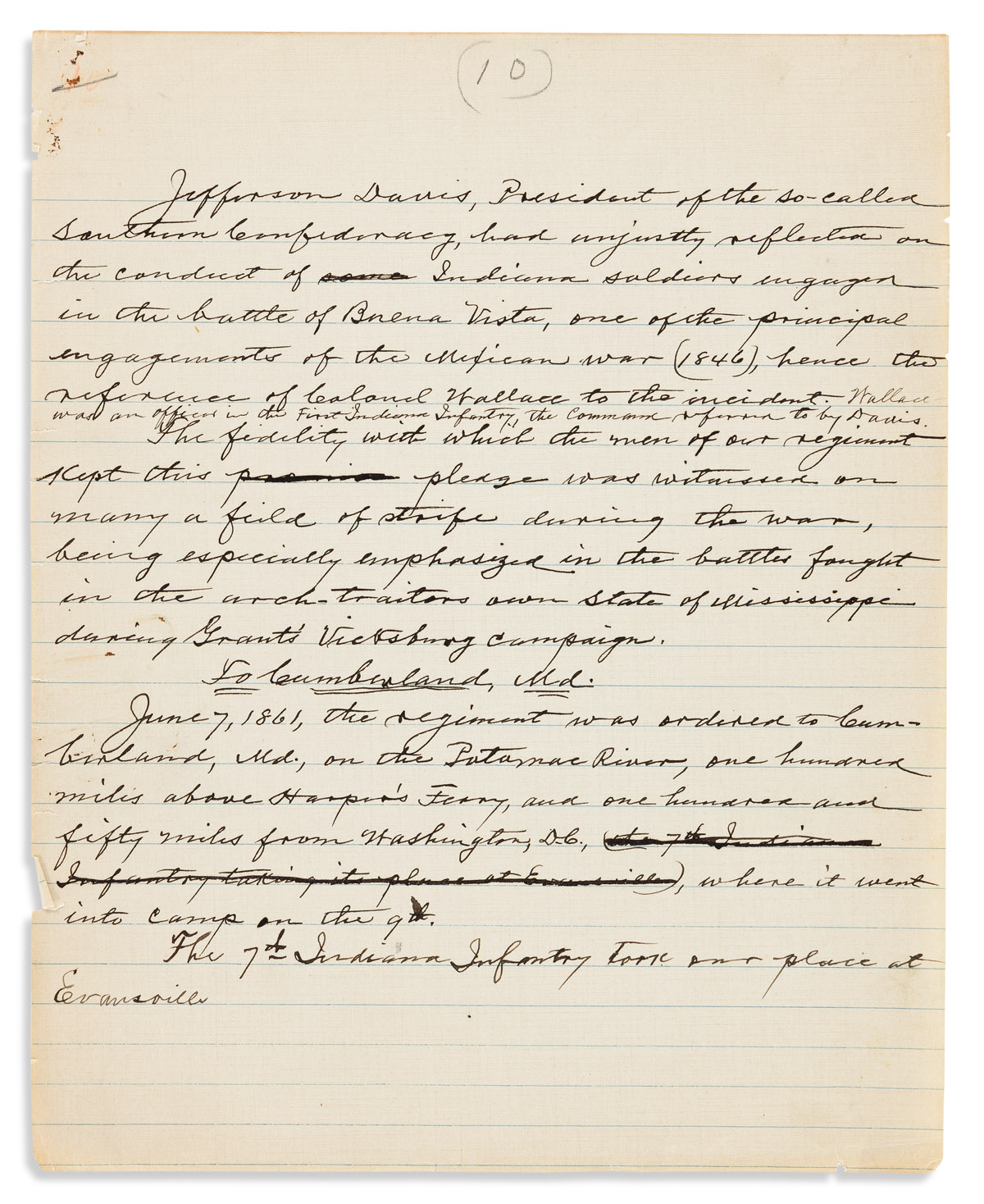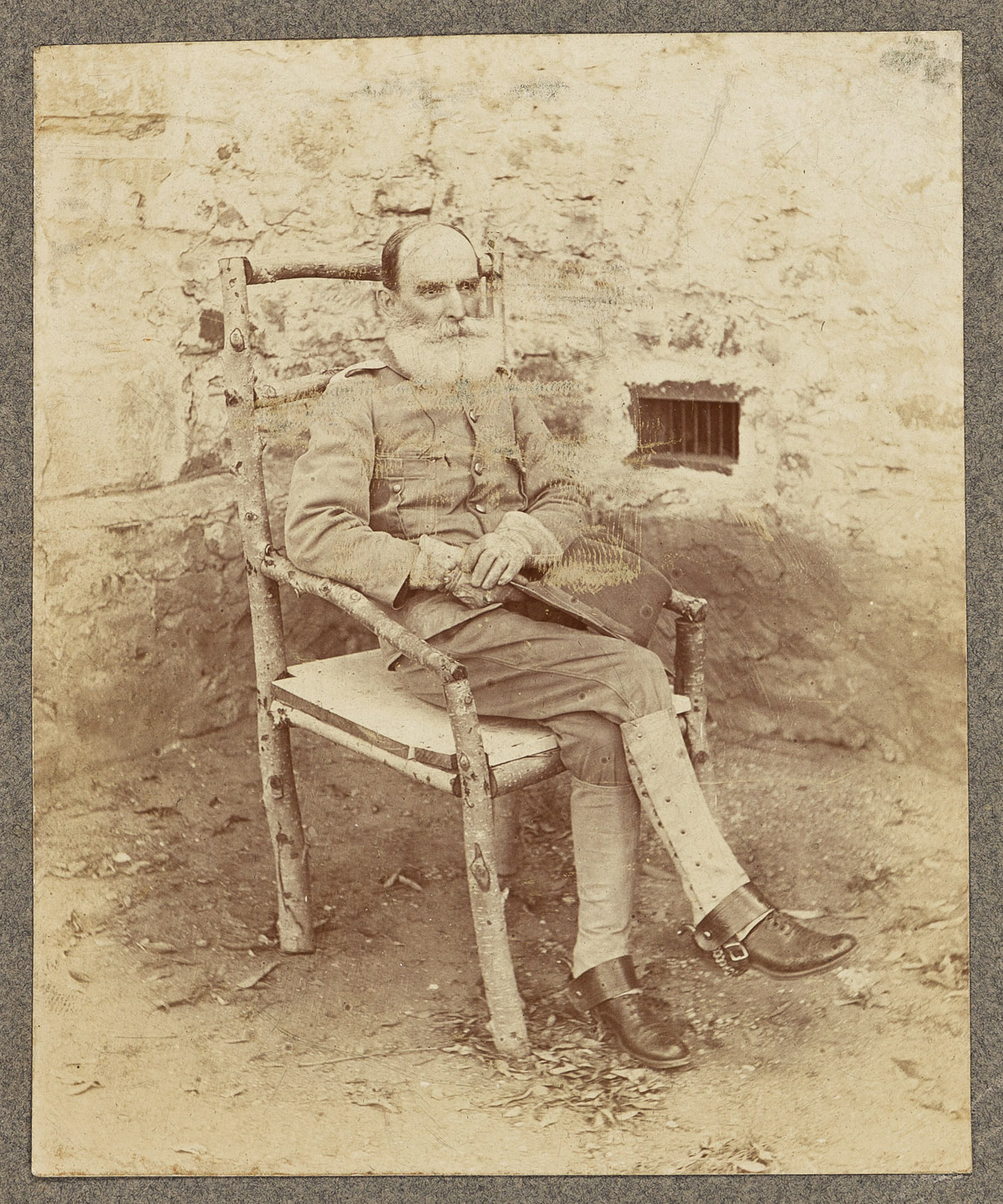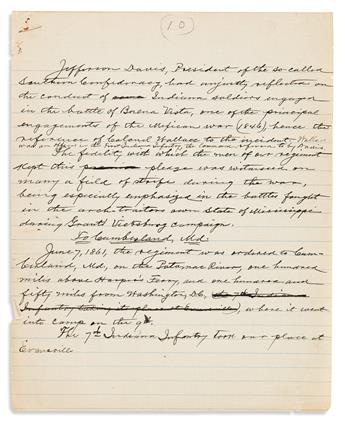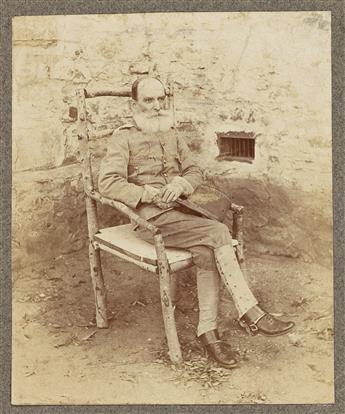Sale 2580 - Lot 104
Price Realized: $ 1,700
Price Realized: $ 2,125
?Final Price Realized includes Buyer’s Premium added to Hammer Price
Estimate: $ 800 - $ 1,200
(CIVIL WAR--INDIANA.) George A. Simmons. Unpublished manuscript memoir of the 11th Indiana Infantry, by one of their officers. Approximately 205 contemporary manuscript pages, all sleeved, plus 74 pages of modern transcripts, in one binder; rough drafts, but condition generally strong. Various places, circa 1864-1920
Additional Details
This regiment had more than the usual share of interesting history. Its founding colonel until his September 1861 promotion was Lew Wallace, who later became a Major General, and then after the war authored the novel Ben-Hur. They distinguished themselves in Tennessee at Fort Henry, Fort Donelson and Shiloh, served in the Siege of Vicksburg, and closed out the war in the Army of Shenandoah. The 11th Indiana is probably unique among all Civil War regiments in having a professional sports team named in their honor: the Indy Eleven of the North American Soccer League.
Unlike many less distinguished regiments, the 11th Indiana did not produce a self-appointed regimental historian who published a thick unit history after the war. ("Three Years with Wallace's Zouaves: The Civil War Memoirs of Thomas Wise Durham" did make it to press in 2003). George A. Simmons (1839-1925) made a considerable effort toward filling that void. He worked as a printer in Indianapolis before the war, enlisted with the 11th as a corporal in its initial incarnation as a 3-month regiment, re-enlisted as a sergeant for a three year term, and mustered out as a second lieutenant in December 1864. After the war, he became an official in the Department of Treasury in Washington.
This memoir by Simmons does not aspire to being an official regimental history. It is largely told in the first person, and makes only brief accounts of the periods when Simmons was away from the regiment--he was captured at the May 1863 Battle of Champion's Hill and not exchanged until the end of August, and then mustered out before the regiment's uneventful last few months of garrison duty. However, it does apparently rely upon research in the published records to keep his chronology straight. It contains numerous interesting anecdotes--navigating by the call of a lone whippoorwill while out on picket duty, Colonel Wallace's creation of a mounted scouting squad to track enemy movements, the initial adoption of a colorful zouave uniform which was "soon discarded for the dark-blue regulation uniform," the unit singing "John Brown's Body" as they marched through Harper's Ferry, sitting on picket duty after the first day's fight at Fort Donelson and hearing the cries of the wounded on the battlefield, and much more. Wallace's drill tactics of "keeping up a continuous fire and advance" are credited for "great saving in casualties . . . notably the case in the approaches to the works of Fort Donelson." The manuscript is numbered erratically from pages 10 to 118 plus two appendices, with several generations of editing marks, covering the entire period of the regiment's active service. It was likely written after his retirement from the Treasury Department circa 1915-1920.
Also included are two shorter works by Simmons. A fragmentary essay titled "General Sheridan's Shenandoah Valley Campaign" concludes with a tribute to fallen comrade Captain John P. McGrew; and an untitled 40-page essay on his Treasury Department work documents his mistreatment toward the end of his career. A most helpful lightly edited modern typescript of the two Civil War works is included with the lot.
Also included are 4 quartermaster returns retained by Simmons from the regiment dated September to December 1864; an official printed Army order from 1886 amending his official service record; a small unmounted albumen photograph of Union soldiers tearing up railroad tracks; and a circa 1900 mounted photograph of an older bearded man in military uniform, presumably Simmons.
Unlike many less distinguished regiments, the 11th Indiana did not produce a self-appointed regimental historian who published a thick unit history after the war. ("Three Years with Wallace's Zouaves: The Civil War Memoirs of Thomas Wise Durham" did make it to press in 2003). George A. Simmons (1839-1925) made a considerable effort toward filling that void. He worked as a printer in Indianapolis before the war, enlisted with the 11th as a corporal in its initial incarnation as a 3-month regiment, re-enlisted as a sergeant for a three year term, and mustered out as a second lieutenant in December 1864. After the war, he became an official in the Department of Treasury in Washington.
This memoir by Simmons does not aspire to being an official regimental history. It is largely told in the first person, and makes only brief accounts of the periods when Simmons was away from the regiment--he was captured at the May 1863 Battle of Champion's Hill and not exchanged until the end of August, and then mustered out before the regiment's uneventful last few months of garrison duty. However, it does apparently rely upon research in the published records to keep his chronology straight. It contains numerous interesting anecdotes--navigating by the call of a lone whippoorwill while out on picket duty, Colonel Wallace's creation of a mounted scouting squad to track enemy movements, the initial adoption of a colorful zouave uniform which was "soon discarded for the dark-blue regulation uniform," the unit singing "John Brown's Body" as they marched through Harper's Ferry, sitting on picket duty after the first day's fight at Fort Donelson and hearing the cries of the wounded on the battlefield, and much more. Wallace's drill tactics of "keeping up a continuous fire and advance" are credited for "great saving in casualties . . . notably the case in the approaches to the works of Fort Donelson." The manuscript is numbered erratically from pages 10 to 118 plus two appendices, with several generations of editing marks, covering the entire period of the regiment's active service. It was likely written after his retirement from the Treasury Department circa 1915-1920.
Also included are two shorter works by Simmons. A fragmentary essay titled "General Sheridan's Shenandoah Valley Campaign" concludes with a tribute to fallen comrade Captain John P. McGrew; and an untitled 40-page essay on his Treasury Department work documents his mistreatment toward the end of his career. A most helpful lightly edited modern typescript of the two Civil War works is included with the lot.
Also included are 4 quartermaster returns retained by Simmons from the regiment dated September to December 1864; an official printed Army order from 1886 amending his official service record; a small unmounted albumen photograph of Union soldiers tearing up railroad tracks; and a circa 1900 mounted photograph of an older bearded man in military uniform, presumably Simmons.
Exhibition Hours
Exhibition Hours
Aliquam vulputate ornare congue. Vestibulum maximus, libero in placerat faucibus, risus nisl molestie massa, ut maximus metus lectus vel lorem.






